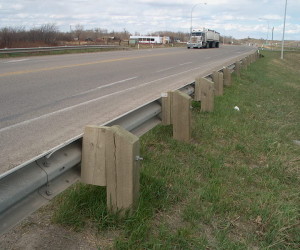Guard rail absorbs the impact of out-of-control vehicles while guiding the vehicle to safer stops. There are three types of guard rail in primary use today.
- Flex Beam
- Thrie-beam
- Cable barrier
Flex Beam
Also called W-beam, flex beam is the cheapest and easiest to install, and thus the most popular guard rail in use today. It consists of a w-shaped piece of steel with either wooden or steel posts. Significant research has gone into the placement of flex beam, and the following are the standard specifications:
- Dimensions: 310 mm high by 83 mm wide (12.25″ x 3.25″).
- Thickness: 2.8 mm or 3.5 mm.
- Guardrail height: The middle of the steel (bolts) should be 550 mm (25 inches) above the pavement edge (i.e. top of guardrail 31 inches above pavement).
- Distance from pavement edge: The two edges should be flush with the pavement.
- Wooden Posts: Either construction grade Southern Pine or Douglas Fir, pressure treated, 203 mm x 152 mm (8″ x 6″).
- Steel Posts: Either 110 x 150 x 4.5 mm (4.3″ x 5.9″ x 0.18″) cold formed C-sections or W150 x 13 (W6x8.5) hot rolled structural shapes conforming to ASTM A36 or A588.
- Galvanizing: 600 g/m2 (56 g/ft2) according to ASTM A924 or A123. Bolts are galvanized to ASTM A153.
End sections can be either turn down or a crash absorption barrier. Most state DOT’s have standards for both, and the manufacturers will build them all to the standard (i.e. you’re not likely to get anything else very cheaply).
The standard specification is AASHTO M180.
Thrie Beam
Thrie beam is similar to flex beam, but with three leading edges instead of two. It is used on bridges and other, generally specialty, applications. Here are the specifications for Thrie beam:
- Dimensions: 508 mm high by 78 mm wide (20″ x 3″)
- Thickness: 2.66 mm or 3.42 mm.
- Guardrail height: The middle of the steel should be 610 mm (24″) above the pavement.
- Distance from pavement edge: The three edges should be flush with the pavement.
- Posts & galvanizing: Same as W-beam. See above.
The standard specification AASHTO M180 applies to both W-beam and thrie-beam.
Cable Barriers
I’ve heard a few people rave about these. Although not all jurisdictions use them they have their die hard advocates. High tension cable barriers are proprietary products and therefore must be installed and maintained according to the manufacturers specifications. They vary substantially in details and methods of installation. Specifiers should review the FHWA’s acceptance letters.
The placement of the cable barrier should be either:
- At the bottom of the ditch/median.
- In the upper part of the road sideslope. The FHWA identifies a region near the bottom of the slope, within which the barrier should not go. This region starts at 0.3 m (1′) from the toe of slope to 2.4 m (9′) from the toe of slope.
All three of these systems fall into the category of flexible guardrail. The other types are rigid and semi-rigid, such as concrete barriers. I will save those for another article.

Speak Your Mind